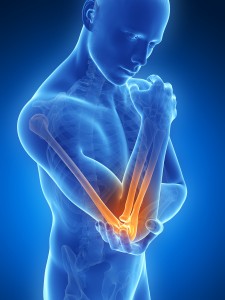Tennis Elbow
Lateral Epicondylitis, also known as Tennis Elbow, is a condition that causes pain where the tendons of the forearm muscles attach to the boney area on the outside of the elbow. Tennis elbow is similar to Golfer’s Elbow, but it occurs on the outside of the elbow, rather than the inside. Tennis Elbow is one of the most common causes of elbow pain and is thought to affect up to 1-3% of the population. Tennis Elbow can be a major problem for tennis players, affecting 10-50% during their careers. Nevertheless, you do not have to play tennis to acquire Tennis Elbow. In fact, fewer than 5% of Tennis Elbow diagnoses are related to tennis.
 Tennis Elbow involves tendons and muscles attached to the outside of your forearm at the lateral epicondyles. The forearm muscles that extend the wrist and fingers, including the Extensor Carpi Radialis Brevis, attach to the lateral epicondyle by a single tendon. Gripping with your hand, or bending the wrist back, causes the wrist extensor muscles to contract and pull on the extensor tendon. When hitting a tennis ball in a backhand swing (and other similar motions), tension on this tendon may increase.
Tennis Elbow involves tendons and muscles attached to the outside of your forearm at the lateral epicondyles. The forearm muscles that extend the wrist and fingers, including the Extensor Carpi Radialis Brevis, attach to the lateral epicondyle by a single tendon. Gripping with your hand, or bending the wrist back, causes the wrist extensor muscles to contract and pull on the extensor tendon. When hitting a tennis ball in a backhand swing (and other similar motions), tension on this tendon may increase.
Symptoms and Causes of Tennis Elbow
The primary symptom of Tennis Elbow is pain and tenderness on the outside of your elbow, which generally builds slowly, but can develop suddenly. The pain may spread down your forearm and wrist, and even to the back of your middle finger and ring finger. A person may feel soreness and tightness in their forearm muscles, or have a stiff elbow that will not straighten out completely. The pain usually increases when; bending the wrist backward, turning the palm upward, moving the wrist forcefully, or holding objects with a stiff wrist or straightened elbow. Shaking hands can make the pain worse. Tennis Elbow is most common in adults between the ages of 30 and 50, and affects men more than women.
Tennis Elbow is one of the most common causes of elbow pain and is thought to affect up to 1-3% of the population. Tennis Elbow can be a major problem for tennis players, affecting 10-50% during their careers. Nevertheless, you do not have to play tennis to acquire Tennis Elbow. In fact, fewer than 5% of Tennis Elbow diagnoses are related to tennis.
Tennis Elbow occurs when tendons of the elbow overextend their ability to heal, typically by repetitive movements of the wrist and arm, or by carrying heavy objects. Too much strain and stress to the tissue may cause a series of tiny tears in the elbow tendons. Jobs that require repetitive straightening and rising of the hand or fist are more likely to develop Tennis Elbow (including carpentry, construction work, landscaping, mechanics, cooking, and house cleaning). Tennis Elbow can also affect athletes in sports that require repetitive arm, elbow and wrist movement, including: tennis, golf, baseball, and bowling. In tennis, repeated use of the backhand stroke can lead to Tennis Elbow.
Diagnosis and Treatment of Tennis Elbow (Lateral Epicondylitis)
Tennis Elbow is not the only cause of elbow pain, so it is important to be evaluated by a physician to determine a proper diagnosis. Left untreated, Tennis Elbow can result in chronic pain. Using the arm too vigorously before the elbow has healed can make the condition worse. At Houston Sports Medicine, Dr. Shaun Lehmann strives to treat elbow pain with nonsurgical treatment options that help your body naturally heal itself. Our physician has years of experience treating pain, and offers multiple nonsurgical treatment options for patients, including: Physical Therapy, Prolotherapy, and Platelet Rich Plasma (PRP). During your initial evaluation, our provider will get a medical history, complete a physical exam, and determine if any diagnostic imaging testing such as MRI or Diagnostic Ultrasound needs to be completed. Once you have been evaluated, our physician will discuss your condition with you and determine a plan of treatment best suited for your condition.
Houston Sports Medicine is located in The Woodlands, TX. The office is easily accessible from the North Houston, Conroe, Tomball, Cypress, Magnolia and The Woodlands communities.
